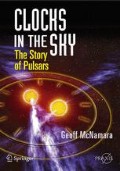Abstract
Jocelyn Bell cycled out to the observatory as she had done many times before. Looking more like a vineyard than a radio telescope, the Interplanetary Scintillation Array — Hewish’s brain child to search for quasars — collected radio signals from space and recorded them as a series of squiggly lines on a paper chart. Among Bell’s jobs were feeding the recorder with paper and filling the ink wells for the recording pens. Her most important job, however, was to sift through the recordings looking for signs of quasars. Computers were around at the time, but it was thought a trained human was better at distinguishing between interference and quasar signals, at least until the astronomers became familiar with the behavior of the telescope. After analysing a hundred meters or so of the chart recordings, the 24-year-old Ph.D. student became rather good at her task. It was impractical to monitor and analyze the recordings in real time, and so Bell waded through the kilometers of paper chart recording after it had accumulated. Then one day in August 1967, she noticed what she would later describe as ‘scruff’ on the recording. Unlike any natural signal she had seen before, it didn’t look artificial either. Puzzling. Although it was probably nothing, she marked it with a question mark and went back to searching the recordings for quasars.
Access this chapter
Tax calculation will be finalised at checkout
Purchases are for personal use only
Preview
Unable to display preview. Download preview PDF.
References
Right Ascension (RA) is the celestial equivalent of longitude. It is measured eastwards from a point on the celestial equator known as the First Point of Aries, which is where the Sun crosses the celestial equator at the March equinox. RA is usually measured in hours, minutes, and seconds, with 24 hours being equivalent to a full circle.
It is now known that this was due to random interstellar scintillation.
For the perfectionist: 1.3372795 seconds. This more precise measurement was made later.
For example, see Robertson 1992, and Mitton 2005.
Quoted in Mitton, 2005.
Quoted in Robertson 1992, p. 305.
In 1972 Burdbidge became the first woman to become Director of the Royal Greenwich Observatory. However, she was denied the title of Astronomer Royal, which was given instead to Martin Ryle. There has never been a female Astronomer Royal.
Science 23 April 2004: Vol. 304. No. 5670, p. 489.
‘Little Green Men, White Dwarfs or Pulsars?’ Cosmic Search Vol. 1, No. 1.
Science 23 April 2004: Vol. 304. No. 5670, p. 489.
Rights and permissions
Copyright information
© 2008 Praxis Publishing Ltd.
About this chapter
Cite this chapter
(2008). ’scruff’. In: Clocks in the Sky. Springer Praxis Books. Praxis. https://doi.org/10.1007/978-0-387-76562-4_4
Download citation
DOI: https://doi.org/10.1007/978-0-387-76562-4_4
Publisher Name: Praxis
Print ISBN: 978-0-387-76560-0
Online ISBN: 978-0-387-76562-4
eBook Packages: Physics and AstronomyPhysics and Astronomy (R0)

